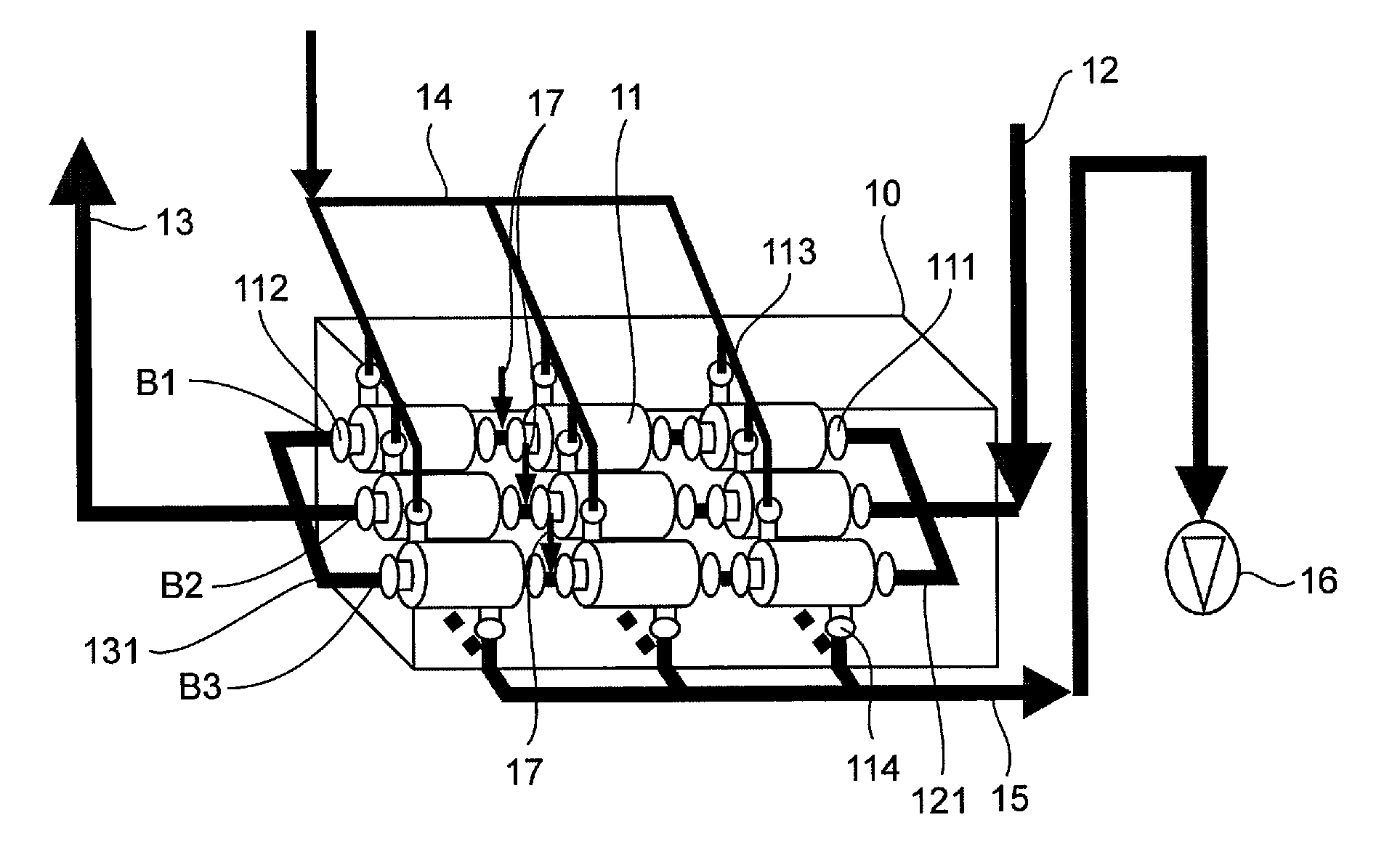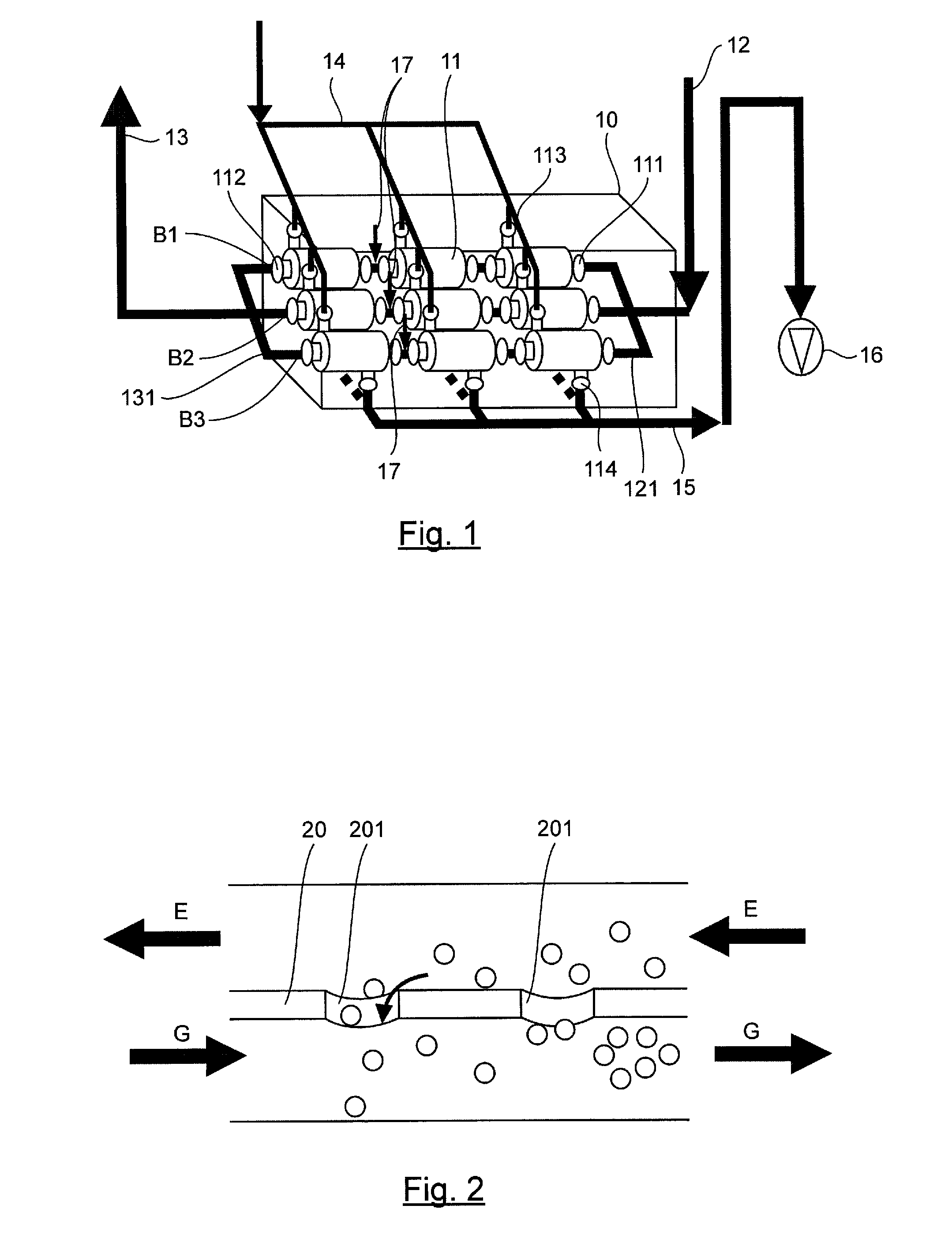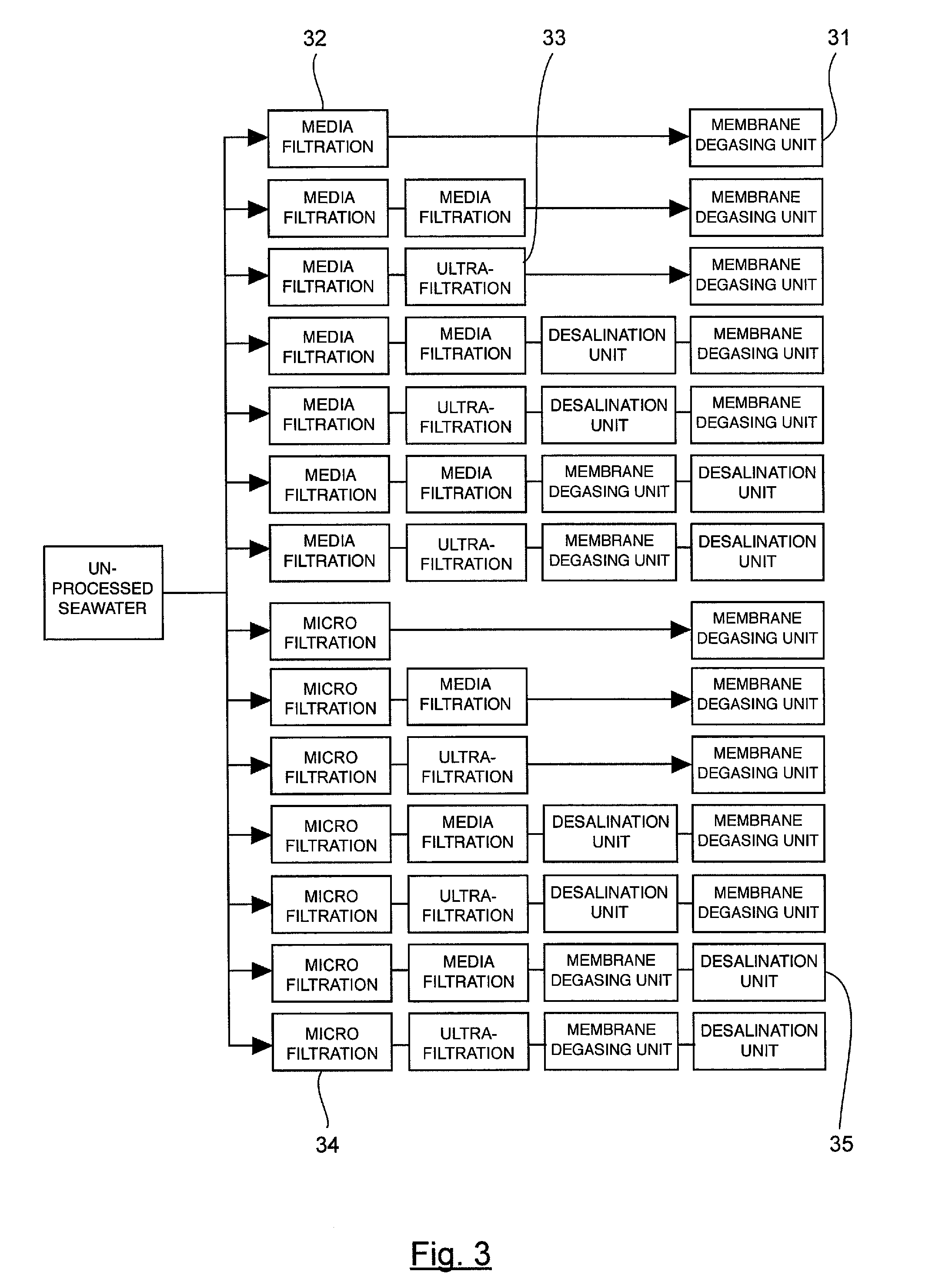Seawater treatment method for the production of injection water for undersea oil drilling and corresponding installation
Inactive Publication Date: 2010-09-16
VEOLIA WATER SOLUTIONS & TECH SUPPORT
View PDF8 Cites 36 Cited by
- Summary
- Abstract
- Description
- Claims
- Application Information
AI Technical Summary
Benefits of technology
[0123]As described in the U.S. Pat. No. 5,352,361, this type of membrane module preferentially houses hollow fibre membranes which extend along an axis essentially parallel to the axis whereby the water to be treated circulates inside the membrane module. These membrane modules also house at least one flow diversion element which extends essentially perpendicularly to the membrane axis. The use of such flow diversion element(s) makes it possible to orient the seawater flow within the membrane module such that it circulates tangentially and transversally with respect to the fibres. The use of these diversion elements enables the creation of dynamic phenomena within the membrane module such that it behaves like a static mixer. In other words, th
Problems solved by technology
For example, it must contain the lowest possible amount of carbon dioxide (CO2) which, once dissolved in water, may increase its acidity and, as a result, its corrosive potential.
These types of methods display drawbacks.
The passage of water in the distribution devices as well as the degassing or stripping phenomenon are accompanied by the formation of gas bubbles or foam which reduce the performances of the deoxygenation process.
However, this results in an increase in the size of the installation so as to be able to treat the same volume of water.
Moreover, these physical methods display efficiency limits.
Thus, in practice, degassing towers make it possible to obtain treated seawater oxygen contents between 50 and 100 ppb, which is insufficient.
However, such a solution may not be reasonably envisaged in that it would result in the use of excessively costly and excessively bulky installations.
However, the use of such chemical products may raise logistic problems due to the problems that may be encountered for the routing thereof to offshore platforms and the storage and limited shelf-life thereof.
Besides the drawbacks described above, the use of degassing or stripping towers also raises installation constraints due to the problems with respect to platform or construction stabilisation.
In addition, the significant weight/surface area ratio thereof results in the oversizing of some parts of metal platform structures.
The use of degassing or stripping towers also has the drawback of lacking flexibility due to the fact that the design thereof cannot be adapted easily to variations in the quality of the seawater to be treated.
A further drawback of thes
Method used
the structure of the environmentally friendly knitted fabric provided by the present invention; figure 2 Flow chart of the yarn wrapping machine for environmentally friendly knitted fabrics and storage devices; image 3 Is the parameter map of the yarn covering machine
View moreImage
Smart Image Click on the blue labels to locate them in the text.
Smart ImageViewing Examples
Examples
Experimental program
Comparison scheme
Effect test
 Login to View More
Login to View More PUM
| Property | Measurement | Unit |
|---|---|---|
| Fraction | aaaaa | aaaaa |
| Fraction | aaaaa | aaaaa |
| Fraction | aaaaa | aaaaa |
Login to View More
Abstract
A method for decreasing the dissolved oxygen content in water used for extracting oil from rocks includes directing water and gas into a housing containing at least one hydrophobic membrane such that the water contacts only a first surface of the membrane and the gas contacts only a second surface of the membrane. The pressure of the gas is decreased thereby causing the oxygen in the water to pass through the first side of the membrane to the second side of the membrane and mix with the gas. A system for decreasing the dissolved oxygen content in water used for extracting oil from rocks includes a plurality of membrane modules. Each module contains at least one hydrophobic membrane. A water supply inlet and a gas supply inlet direct water over the first and second surface respectively of each of the hydrophobic membranes. A water outlet and a gas outlet direct water and gas respectively out of the plurality of membrane modules.
Description
FIELD OF THE INVENTION[0001]The field of the invention is that of seawater treatment.[0002]More specifically, the invention relates to the treatment of seawater within the scope of oil drilling water production particularly on offshore platforms or constructions.PRIOR ART AND DRAWBACKS OF THE PRIOR ART[0003]Oil is contained in more or less porous and permeable rocks.[0004]The oil extraction process includes two main phases: a so-called primary production phase and a so-called secondary production phase.[0005]The primary production phase consists in extracting the oil trapped in these rocks (or reservoirs) under the only effect of the pressure applied.[0006]The secondary production phase consists in continuing the extraction of the oil contained in these rocks by injecting water, which is frequently referred to as injection or pressure maintenance water, therein.[0007]In offshore operations, pipes are used to carry the injection water, and transport the hydrocarbons extracted from th...
Claims
the structure of the environmentally friendly knitted fabric provided by the present invention; figure 2 Flow chart of the yarn wrapping machine for environmentally friendly knitted fabrics and storage devices; image 3 Is the parameter map of the yarn covering machine
Login to View More Application Information
Patent Timeline
 Login to View More
Login to View More IPC IPC(8): C02F1/20B01D19/00B01D63/00C02F1/70
CPCB01D19/0031B01D61/246B01D2311/12B01D2317/02B01D2317/04B01D2325/38E21B43/20C02F1/44C02F1/70C02F2103/08C02F2201/001E21B41/02C02F1/20Y02A20/131B01D19/00B01D61/14B01D63/04E21B43/00
Inventor BIGEONNEAU, DIDIERSUBLET, RENAUDSUTY, HERVEEWANS, WAYNE
Owner VEOLIA WATER SOLUTIONS & TECH SUPPORT
Features
- R&D
- Intellectual Property
- Life Sciences
- Materials
- Tech Scout
Why Patsnap Eureka
- Unparalleled Data Quality
- Higher Quality Content
- 60% Fewer Hallucinations
Social media
Patsnap Eureka Blog
Learn More Browse by: Latest US Patents, China's latest patents, Technical Efficacy Thesaurus, Application Domain, Technology Topic, Popular Technical Reports.
© 2025 PatSnap. All rights reserved.Legal|Privacy policy|Modern Slavery Act Transparency Statement|Sitemap|About US| Contact US: help@patsnap.com



